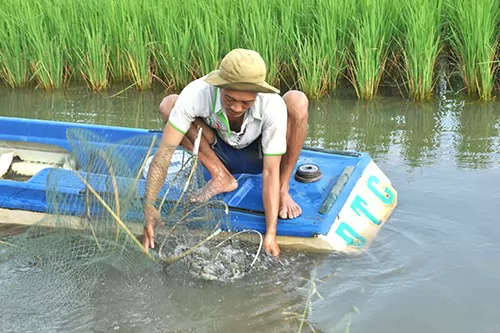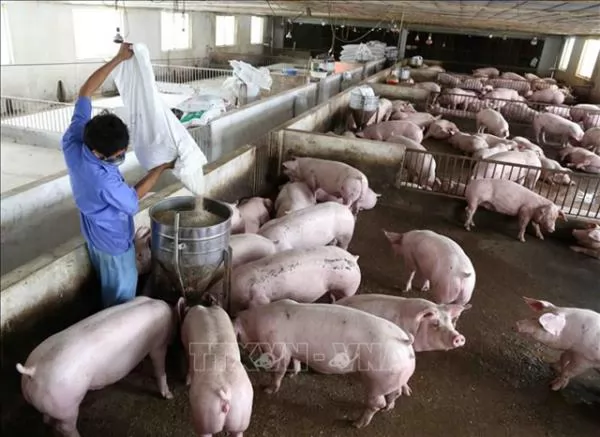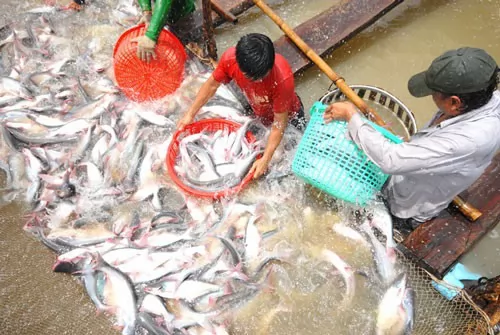Trà Vinh shrimp farmers earn more from staggered breeding

A rice field used for both growing rice and breeding aquatic species like shrimp in Long Hòa Commune in Trà Vinh Province’s Châu Thành District. – VNA/VNS Photo Thanh Hòa
Viet Nam News / TRÀ VINH — Giant river prawn farmers with more than one pond in the Mekong Delta province of Trà Vinh increased their incomes by staggering the release of prawn fry into their ponds through the last breeding season to ensure there was no oversupply and prices remained high.
In the past, farmers used to release and thus harvest the prawns together, running the risk of oversupply and losses if prices declined.
But this time, they were advised by local agricultural officials to stagger the release.
Nguyễn Văn Nam, who has bred the prawns in Châu Thành District’s Long Hòa Commune for five years, said he earned VNĐ200 million (US$8,620) from two ponds with a total area of 1.2ha in the 2018-19 season.
At the beginning of the season he began to breed fry in one pond and a month later in the other.
After eighth months he harvested the largest prawns (making eight to 12 to a kilogramme) in the first pond and left the smaller ones untouched. One month later, he did the same in the second pond.
He kept harvesting the prawns when they reached market size, and this way he harvested them several times during the crop, he said.
Giant river prawn is one of the aquatic species that Trà Vinh authorities encourage farmers to raise in both brackish water and freshwater since it is easy to breed and resistant to diseases.
Giant river prawns can live in water with a salt content of 0.4-0.6 per cent and so can adapt to areas affected by saltwater due to climate change.
The province has some 2,100 households raising them in nearly 2,000ha of ponds and producing 1,500 tonnes annually, according to the province’s Fisheries Sub-department.
They earn an average of VNĐ50 – 70 million ($2,155 – 3,120) per hectare per year.
Households who breed only male prawns earn up to 1.5 times more than those breeding both sexes.
The giant river prawn, black tiger shrimp and white-legged shrimp are the province’s major shrimp species and are bred in brackish water.
Fry management
Trà Vinh has 30,000ha of brackish water where more than five billion shrimp are bred annually, according to the Department of Agriculture and Rural Development.
But there are only 48 establishments producing fry which meet only 45 per cent of local demand.
The province thus has to buy fry from other elsewhere, mostly from the neighbouring province of Bạc Liêu and south central provinces of Ninh Thuận and Bình Thuận.
Phạm Minh Truyền, director of the department, said it was difficult to monitor the quality of fry since the province buys large volumes from other provinces.
Many farmers in Trà Vinh have been affected by the slow growth of their shrimp this year because of the poor quality of fry, according to the department.
Lê Thị Nhàn, who has a 0.3ha pond in Cầu Ngang District’s Vinh Kim Commune, said she bred 15,000 white-legged shrimp fry this year and they only reached a weight of 99 to a kilogramme after two and a half months.
In previous crops, they would often reach a weight of 82 to a kilogramme within two months, she said.
Ten of her neighbours also faced the same situation this year, she added.
To improve oversight of fry quality, Trà Vinh has signed agreements with provinces from which it buys them.
Besides it has solicited investment in farms to produce fry.
The province breeds shrimp under various models like industrial farming, extensive farming, breeding in mangrove forests, and farming shrimp in rice fields in the dry season. – VNS
Maybe you are interested

Farmers see higher profits from sustainable shrimp–rice farming model
Viet Nam News / HCM CITY – The shrimp-rice farming model in Cà Mau Province, the largest shrimp producer in the Mekong Delta, has offered a stable income for farmers.

Animal husbandry must go high-tech for export expansion
Animal husbandry in Việt Nam must apply high-tech solutions to produce products meeting quality requirements of foreign markets

Fish exporters left lost at sea
HÀ NỘI — Unfair and unreasonable – that’s how seafood exporters have branded a price hike in anti-dumping duty imposed by the United States on frozen fish fillets.





